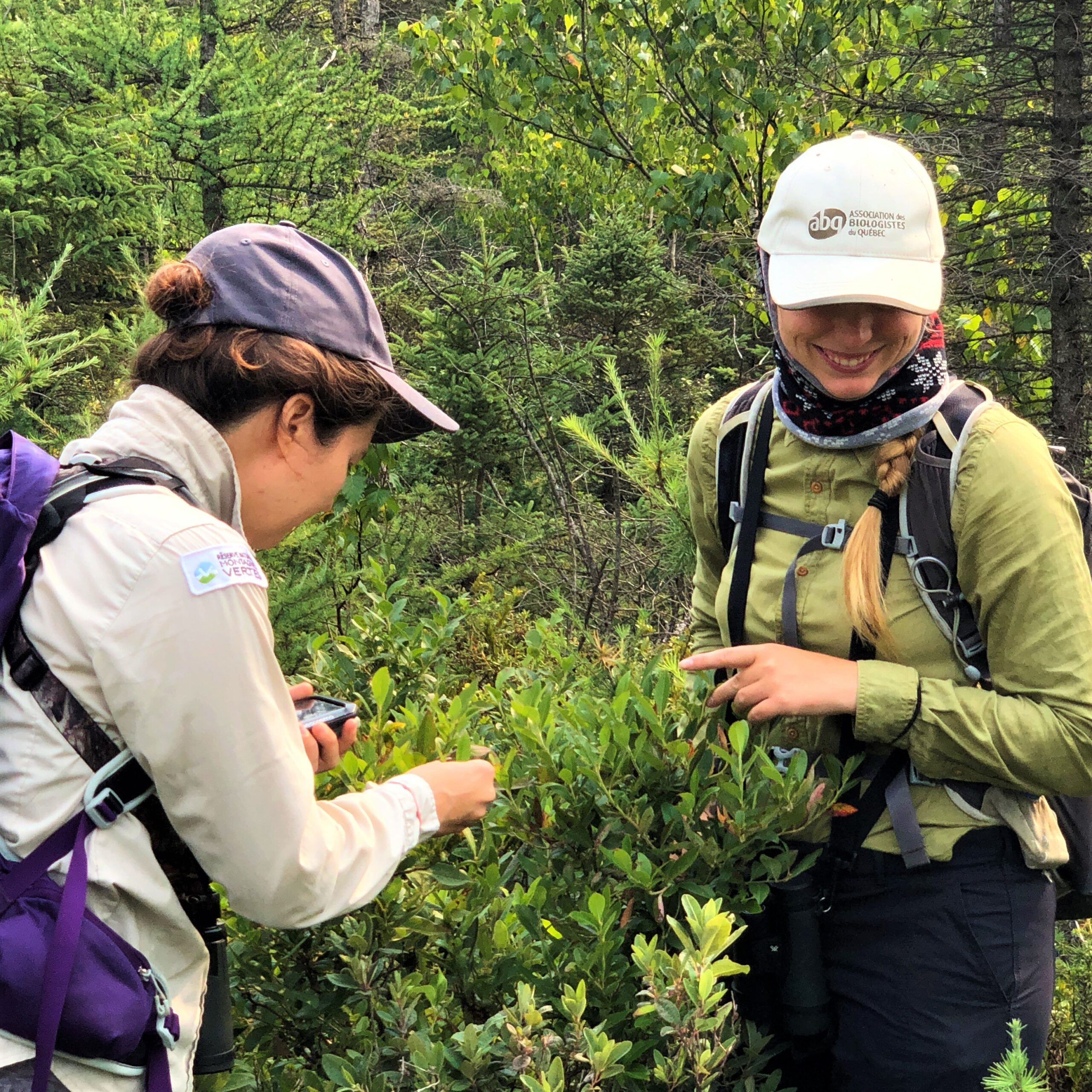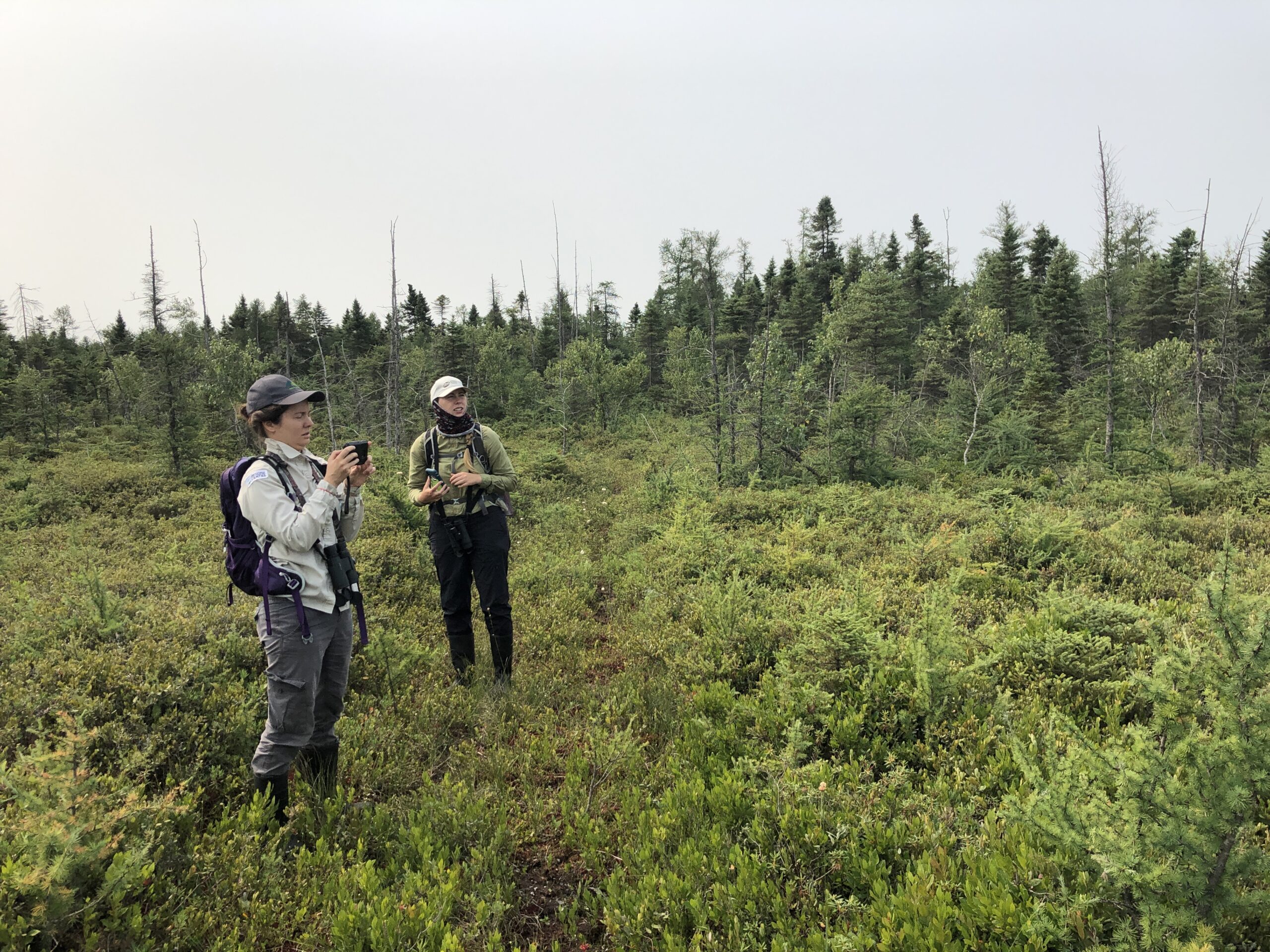
07 Sep BIOLOGIST FOR A DAY WITH APPALACHIAN CORRIDOR
By Marie-Hélène Thibeault
 Me, Melanie and Tanya ready for a day of discovery!
Me, Melanie and Tanya ready for a day of discovery!
Thanks to an internal initiative at Appalachian Corridor, I had the chance to leave my comfortable office chair and join my biology colleagues for a day of field work in the summer of 2021.
Normally, as the person in charge of communications and philanthropy for our organization, I am glued to my computer to revise texts, prepare communication plans, participate in conference calls with partners and plan an upcoming fundraising campaigns. But this time, I put on my hiking boots and outdoors clothing to join Mélanie Roy and Tanya Vinet on one of their biology knowledge-acquisition mandates.
Our day started at 8am with a drive to the designated land. A short 30 minutes later, we arrived at our destination and it was time to prepare for our day of work: backpacks, water bottles, neck warmers to avoid ticks and mosquitoes, tablets and batteries to orient ourselves and count the species we found, cell phones and applications to identify the species we discovered and our lunches.
As soon as we got out of the car, Melanie and Tanya were already hard at work .
“Did you hear that?” said Melanie. “Oh yes, I did! It’s an indigo passerine,” replied Tanya, who took the opportunity to add this species to the application dedicated to counting the biodiversity present on the site.

Melanie is all ears to identify birds on site and equipped with a multitude of applications to validate her listening.
Even before we took our first steps, my colleagues had already identified a dozen species of birds – by listening and through visual observations. For a neophyte like me, it was fascinating to see how easily they could recognize the songs of all these lovely singers!
After learning about the birdlife on site, we began our walk to specific points on a land with a total area of over 700 hectares. Our objective for the day: survey the flora and fauna at various locations in order to better understand the biodiversity and ultimately protect the species living there.
The first 500 meters proved to be easier, as we were walking along a farmland road. Melanie and Tanya took advantage of each step to look around and take note of their wildlife and plant observations. Things were going smoothly and I imagined that at this pace, the day would flow smoothly!
However, it was precisely at that same moment that things took a new turn. “That’s the way to go!” said Melanie who was following the GPS rigorously, pointing directly to the adjacent forest.

Because there are no trails or landmarks on the ground, Melanie and Tanya often use their high performance GPS to find their way to the next evaluation point. As long as I could see where our car was located, I felt confident!
Being used to well-marked and clear hiking trails, I was a bit skeptical since I could not see any official entrance… only trees and shrubs. But the girls had one goal in mind, and to reach the point on the map, we had no choice but to get into a very dense forest with only the GPS and some very narrow deer trails to guide us.
We managed to cross a first forested segment to arrive at a different habitat: a peat bog. The changes from farmland to forest and then to the bog were noticeable. The bog had very wet and rich soil, mossy vegetation, small shrubs, and some carnivorous plants I had never seen before. It was the perfect environment for my colleagues to compile data on the species present.
Faced with nature’s immensity and abundant diversity, my eyes could not distinguish each element constituting the whole.
“How do you keep track of everything? I wouldn’t know where to start” I admitted to the girls.
“We start with the sky and work our way down,” Tanya replied.
So, they proceeded to awaken all their senses in order to grasp the magnitude of the nature that surrounded us. Once the birds were counted, they proceeded to look at the stands of trees, to then evaluate the shrubs and finally to descend to the ground level.
I was confused as I listened to them talk. “This one? Do you think it’s Gaylussacia baccata or rather Vaccinium corymbosium?” asked Tanya to Melanie. In return, Melanie asked Tanya: “And this one? Look at these leaves. Is that a Canadian Rhododendron or a Narrow-leaved Kalmia?”

It seemed like quiz time on the biology baccalaureate! But what is this species?
Tanya and Melanie question and analyze!
At each census point, I observed my fellow colleagues carefully look at each leaf and flower specimens, turning them, smelling them, touching them, watching the light pass through them… to identify them properly and then record their data in an application on their tablet.
When they came across an enigma, they used applications like iNaturalist and Seek to validate their research. I took the opportunity to download iNaturalist myself. On a few occasions, I had fun taking pictures of specimens and identifying them using the application…. For a brief moment, the application made me feel just a little less ignorant about their mastery of species names!
After counting the species present at given points over a distance of about two kilometers in three hours, we took a lunch break. It was past noon and a balmy, humid 30 degrees in the wet bog environment. We decided to walk a little further to our next census point hoping to eat our lunch in the shade under some beautiful mature trees. Secretly, I was hoping to find a nice body of water to jump in to cool off… obviously, I had forgotten that we were at the crossroads of large agricultural areas with a rich bog environment!

Tanya and Melanie getting ready to cross a small muddy stream.
In the middle of a virgin forest, there is rarely a small bridge waiting for us!
We have to use our creativity, sometimes our courage, and also put nature to work!
We finally found a small peaceful place to break bread in the middle of a forest stand to sit on a piece of broken tree trunk.
“What are you passionate about in your work,” I asked the girls in between bites of bagel.
“For me, knowledge acquisition projects are real adventures and I love the idea of finding a species I’ve never seen before,” shared Melanie who initially completed a Bachelor’s degree in Communication, Writing and Multimedia at the University of Sherbrooke before making the leap to Biological and Ecological Sciences at the University of Quebec at Trois-Rivières, following a communications internship at Appalachian Corridor nearly 10 years ago.
Tanya, who initially worked in the field of occupational therapy before turning green with a Bachelor’s degree in ecology and a Master’s degree in environmental management at the University of Sherbrooke, added: “Our work helps protect species and it’s super rewarding!”
Before I knew it, we had finished our little meals and were heading back to complete another two kilometer walk with a few census points.
Although we observed many of the same species as in the morning, the challenge of the afternoon remained navigating through large blocks of shrubs without a trail. We trudged along trying to carve out a path. Fortunately, my guides kept motivated and fueled by sampling the small berries along the way!
Thanks to the GPS, we managed to find our car after a four-kilometer trek and six active hours of walking on the ground.
“Are you satisfied with your day?” I asked the girls. “Yes,” said Melanie. “We never know what to expect when we get to a field, but the important thing is to make progress and make data entries that are accurate and of quality.”



A highlight of the day for me, beyond getting to the car (!), was taking photos of beautiful species and nature at its purest.
At the car, I quickly removed my sweater and heavy boots to put on my sandals and air out my feet in the blazing sun. Although I regularly run and mountain bike, I felt a different kind of fatigue as if I had just completed an episode of Survivor in Alaska in a remote and hostile environment!
On the way home, I replayed the day’s scenario in my head and felt fortunate to have witnessed this beautiful and pristine natural setting. Witnessing my colleagues’ work and seeing Appalachian Corridor’s mission come to life right in front of my eyes had given me a deeper appreciation for our efforts.
I was all the more admiring of my colleagues who had to continue their work the next day on another land while I was back in the comfort of my office! There is no rest for Appalachian Corridor’s biologist with 21 ecological assessment planned for this summer alone!
But fortunately and thanks to all my colleagues, conservation does not rest!
SUMMARY OF THE DAY
- 2 biologists and a nature lover!
- 4 kilometers walk
- 6 hours of walking in the very dense forest
- About 50 different species were counted during the day
- We observed 25 species of birds and we ended the day with three species of mammals
- Among the species with status recorded, we found the barn swallow and the Virginia woodwardie (a fern).
- We also came across carnivorous plants: Roundleaf Cattail and Purple Pitcher Plant.
Appalachian Corridor has a backlog of 21 learning projects this summer. Several projects require multiple visits to complete a full ecological assessment of the site.
APPLICATIONS USED BY OUR EXPERTS
To support all their knowledge and validate their assessments, our experts use the following apps throughout their field trips for species identification:
- Seek, to identify plants
- eBird, when we want to share our bird observations
- Merlin Bird ID and Sibley V2, to help identify birds. They are like paper guides, but you can listen to tapes of their songs and calls
- BirdNET, allows you to record a bird song, then the app analyzes it and suggests the species it could be. It’s a Shazam-like app, but for bird songs!

